#Zanskaris
Text
Explore the Hidden Gem of Leh & Ladakh - Purne Village
Nestled in the heart of the Zanskar Valley, Purne Village is a serene and captivating destination that will leave you spellbound. This remote village is located in Leh & Ladakh and is known for its rich history, culture, and natural beauty. In this comprehensive guide, we will take you on a journey through Purne Village and help you discover its hidden gems.
History and Culture
Purne Village…
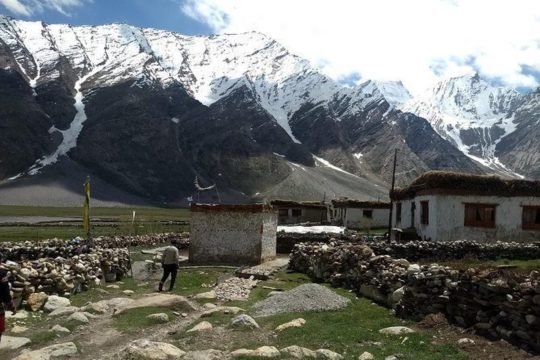
View On WordPress
#Leh & Ladakh#padum#Phugtal Monastery#purne village#shinkula pass#Tsarap River#zanskar valley#Zanskaris
1 note
·
View note
Photo

Night Out at Gonbo
Gonbo Rongjon is a sacred mountain of the Zanskari people of Ladakh, India
Photographer: Santanu Majumder
#santanu majumder#photographer#gonbo rongjon#mountain#sacred mountain#landscape#zanskari people#ladakh#india#nature#night sky#milky way
61 notes
·
View notes
Text
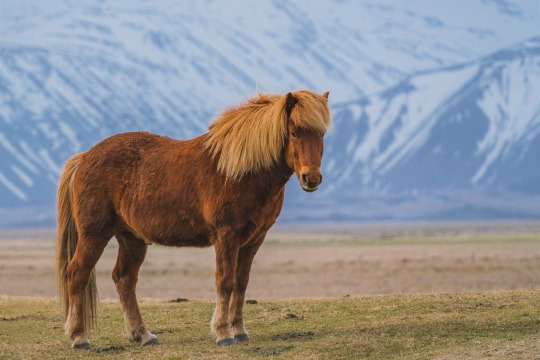
Zaniskari
#zaniskari#zanskari#wikipedia#wikipedia pictures#nature#animals#horse#horses#horse breeds#horse breeding#mountain horse#pony#workhorse#zanskar valley#ladakh#india
46 notes
·
View notes
Text
#marwari#kathiawari#spiti#bhutia#manipuri#zanskari#bhimthadi#deccani#chummarti#sikang#horses#india#indian horses
1 note
·
View note
Photo

Curated Experiences in the Indian Himalaya. To the lesser known remote region of Zanskar aka Zangkhar. In the footsteps of Zanskarpas who have traced these ancient paths for centuries. Explore Zanskar every summer with @hippie_in_hills in a manner respectful of the natural environment and its inhabitants. We travel in small groups allowing us close contact with locals attaining a truly memorable experience. Understand the different ways of life other than your own. Ask us to know more about our Standard summer tours and treks to Zanskar or Customise a Travel plan as per your requirements. . . #zanskar #zangkhar #ladakh #southernladakh #zanskari #zanskarpas #buddhist #buddhism #ladakhi #karshamonastery #padum #phuktalmonastery #wayoflife #tibetan #gompa #gonpa #mindfultravel #ecotourism #travel #exploration #explore #westernhimalaya #indianhimalayas #himalaya #incredibleindia #dekhoapnadesh #travelwithhippieinhills #explorewithhippieinhills #hippieinhills #vocalforlocal (at Zanskar) https://www.instagram.com/p/CmYUptJJ05j/?igshid=NGJjMDIxMWI=
#zanskar#zangkhar#ladakh#southernladakh#zanskari#zanskarpas#buddhist#buddhism#ladakhi#karshamonastery#padum#phuktalmonastery#wayoflife#tibetan#gompa#gonpa#mindfultravel#ecotourism#travel#exploration#explore#westernhimalaya#indianhimalayas#himalaya#incredibleindia#dekhoapnadesh#travelwithhippieinhills#explorewithhippieinhills#hippieinhills#vocalforlocal
1 note
·
View note
Text
Chadar Frozen River Trek: A Mesmerizing Odyssey Through the Icy Abyss

The Chadar Frozen River Trek, orchestrated by Himalayan Adventure Trips, stands as an extraordinary adventure that unfolds amidst the mystical landscapes of Ladakh. Trekking along the frozen Zanskar River, adventurers immerse themselves in a surreal world where icy terrain meets ethereal beauty.
Traversing the frozen riverbed, participants witness the unique phenomenon of the Chadar, a breathtaking sheet of ice forming on the Zanskar River. This surreal trail amidst towering cliffs, frozen waterfalls, and snow-laden landscapes creates an otherworldly experience. The trek demands more than physical endurance; it requires a mental fortitude to navigate the challenging icy paths and adapt to the harsh yet captivating terrain.
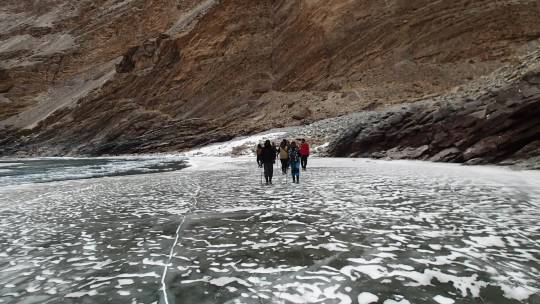
Itinerary of Chadar Frozen River Trek:
Day 1: Arrival in Leh
Arrive at Leh, the starting point of the Chadar Trek.
Acclimatization and rest to adjust to the high altitude.
Explore Leh and visit local attractions.
Day 2: Leh to Tilad Do and Shingra Koma
Drive from Leh to Chilling and then trek to Tilad Do.
Continue the trek towards Shingra Koma, walking on the frozen Zanskar River.
Camp overnight in Shingra Koma.
Day 3: Shingra Koma to Tibb Cave
Trek along the frozen river, passing through Narrows and Gorges.
Witness magnificent views of frozen waterfalls and icy cliffs.
Reach Tibb Cave and set up camp for the night.
Day 4: Tibb Cave to Naerak
Trek further to Naerak, passing through breathtaking landscapes.
Marvel at the stunning frozen cascades and unique ice formations.
Camp overnight at Naerak, near the frozen waterfall.
Day 5: Naerak to Tibb Cave
Begin the return journey, trekking back towards Tibb Cave.
Retrace the path through the gorges and icy trails.
Overnight camping at Tibb Cave.
Day 6: Tibb Cave to Shingra Koma
Trek back from Tibb Cave to Shingra Koma.
Enjoy the serenity of the frozen river and panoramic views.
Camp overnight at Shingra Koma.
Day 7: Shingra Koma to Tilad Do and Leh
Trek back to Tilad Do from Shingra Koma.
Drive back to Leh from Tilad Do.
Overnight stay in Leh.
Day 8: Rest and Explore Leh
Reserve the day for relaxation and exploration in Leh.
Visit local markets, monasteries, or indulge in cultural experiences.
Day 9: Departure from Leh
Departure from Leh, concluding the Chadar Frozen River Trek adventure.
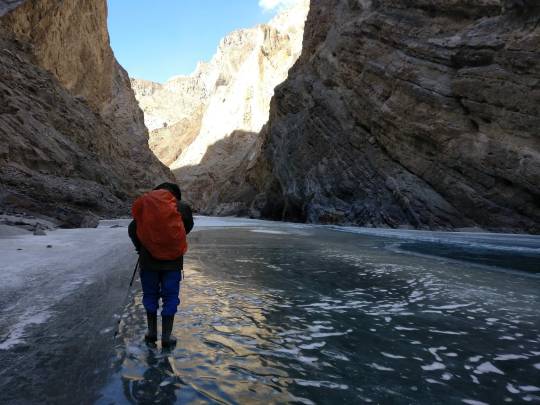
Skills Required for Chadar Frozen River Trek:
Proficiency in trekking in extreme weather conditions, walking on icy terrains, and maintaining balance.
Ability to adapt to changing weather and physical challenges encountered during the trek.
Key Points of Chadar Frozen River Trek:
Trekking along the frozen Zanskar River, experiencing the unique Chadar phenomenon.
Understanding the importance of acclimatization, safety measures, and following the guidance of experienced guides.
Highlights of Chadar Frozen River Trek:
The Chadar Frozen River Trek, a remarkable adventure amidst the stunning landscapes of Ladakh, boasts several captivating highlights that make it a unique and sought-after trekking experience:
Spectacular Natural Phenomenon:
Walking on the frozen Zanskar River, encountering the mesmerizing Chadar, a thick sheet of ice formed on the river surface during the winter months. This natural marvel creates a surreal pathway amidst the icy canyon walls.
Unparalleled Scenic Beauty:
Immersive trekking amidst breathtaking snow-covered landscapes, towering cliffs, and frozen waterfalls along the Zanskar River.
Pristine vistas of the Ladakhi Himalayas, offering panoramic views of the majestic snow-clad peaks.
Adrenaline-Pumping Adventure:
Traversing the icy terrain and challenging conditions, including walking on frozen river surfaces, navigating through icy patches, and crossing frozen water bodies, adding an element of thrill to the trek.
Cultural Encounters:
Interacting with local Zanskari residents in remote villages, providing insights into their unique lifestyle, traditions, and hospitality despite the harsh winter conditions.
Spiritual and Tranquil Ambiance:
A serene and tranquil environment enveloping trekkers as they trek through the snow-covered landscapes, creating an aura of peaceful solitude amidst nature's frozen beauty.
Unique Photography Opportunities:
Abundant opportunities for photography enthusiasts to capture the surreal landscapes, the glistening ice formations, and the raw beauty of the frozen riverbed.
Challenging Yet Rewarding Experience:
Testing physical endurance and mental fortitude while trekking through extreme cold, navigating icy trails, and adapting to the challenging weather conditions, making the trek a rewarding accomplishment.
Expert Guidance and Camaraderie:
Guided by experienced trek leaders and support staff, fostering a sense of camaraderie among fellow trekkers, sharing the challenges and triumphs of the expedition. The Chadar Frozen River Trek is a blend of natural beauty, adventure, cultural immersion, and personal achievement, offering an unforgettable journey through the frozen landscapes of Ladakh, making it a bucket-list-worthy experience for adventure enthusiasts worldwide.
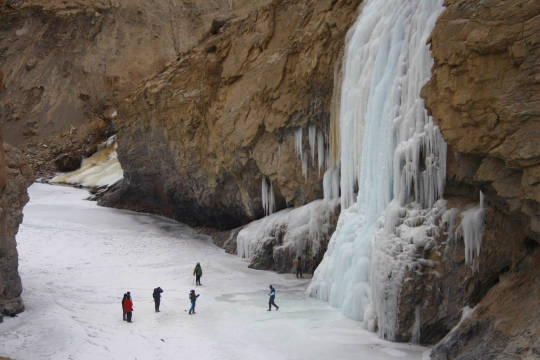
Perfect Time to Visit Chadar Frozen River Trek:
The best time to embark on the Chadar Frozen River Trek is during the winter months, particularly from January to mid-February. This period offers the ideal conditions for the formation of the iconic Chadar or blanket of ice on the Zanskar River, creating a unique and breathtaking trekking trail.
The trek is primarily undertaken during the coldest months of Ladakh's winter when the temperatures drop significantly, allowing the Zanskar River to freeze over. The frozen river forms a surreal and spectacular pathway, attracting adventure enthusiasts from around the world to experience this one-of-a-kind trekking adventure.
Key considerations for the best time to visit the Chadar Frozen River Trek include:
January to mid-February: This period is generally the peak season for the Chadar trek as it offers the most stable and fully-formed ice trail, providing an immersive experience amidst the frozen landscape.
Note: The timing for this trek largely depends on weather and local conditions. The Chadar formation may vary from year to year based on temperature fluctuations and snowfall.
It's crucial to plan the trek during this specific window to ensure the presence of a stable ice trail and to experience the awe-inspiring beauty of the frozen river at its best. Trekkers are advised to stay updated on weather forecasts and consult with experienced trek organizers like Himalayan Adventure Trips - Best trekking company in India to choose the optimal time for the Chadar Frozen River Trek.
Things Himalayan Hikers Recommend forTrek:
Adequate Clothing:
Layered clothing appropriate for extreme cold conditions, including thermal wear, fleece jackets, and insulated waterproof jackets and trousers.
Good-quality, warm socks, gloves, and headwear (hats/beanies) to protect against the biting cold.
High-Quality Trekking Gear:
Sturdy and waterproof trekking boots with excellent grip to navigate icy trails and rocky terrain.
Gaiters to prevent snow and water from entering boots.
High-quality trekking poles for better balance and support on the frozen river.
Sleeping Gear:
A well-insulated sleeping bag suitable for sub-zero temperatures to ensure a comfortable sleep during camping nights.
Hydration and Nutrition:
A hydration system (water bottles or a hydration pack) to ensure regular intake of fluids. Ensure fluids don't freeze; use insulating covers or keep them close to the body.
Energy-rich snacks, nuts, chocolates, and dry fruits to maintain energy levels during the trek.
Personal Health and Safety:
Adequate acclimatization: Spend a day or two in Leh for acclimatization before starting the trek to adjust to high altitudes.
Carry essential medications and a basic first aid kit for emergencies.
Physical Fitness and Mental Preparation:
Prior physical conditioning and endurance training to cope with the challenges of walking on icy terrains and long distances.
Mental resilience and a positive mindset to face unpredictable weather conditions and adapt to changing circumstances.
Respect for the Environment and Local Culture:
Adherence to leave-no-trace principles: Maintain cleanliness by carrying back all non-biodegradable waste.
Respect local customs and traditions of the region and follow guidance provided by local guides or Himalayan Adventure Trips.
Trekking in Groups and Following Guides:
Trek in a group, following the lead of experienced guides from the trek organizer for safety and proper navigation along the Chadar trail.
By adhering to these recommendations, trekkers can better prepare themselves for the unique challenges and beauty of the Chadar Frozen River Trek, ensuring a memorable and safe expedition through the frozen landscapes of Ladakh.
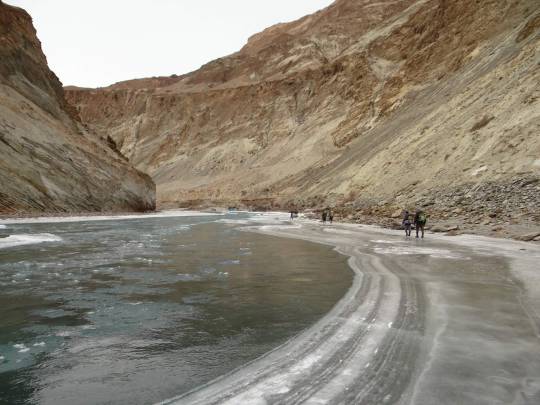
How to Reach Chadar Frozen River Trek:
Reaching the Chadar Frozen River Trek involves arriving at Leh, which serves as the starting point for this adventurous expedition. Here's how to reach Leh:
By Air:
The most common way to reach Leh is by air. The Kushok Bakula Rimpochee Airport in Leh operates regular flights from major cities like Delhi, Mumbai, and other major Indian cities.
From the airport, participants can arrange for transport to the designated meeting point for the Chadar Frozen River Trek, typically organized by the tour operator, Himalayan Adventure Trips.
By Road:
Leh is also accessible by road, primarily through two routes:
Manali-Leh Highway: A scenic but challenging road trip from Manali to Leh that usually opens in late May or early June, depending on weather conditions.
Srinagar-Leh Highway: Another picturesque road route from Srinagar to Leh that generally opens earlier than the Manali-Leh Highway.
Participants can travel by bus, taxi, or their private vehicle along these routes to reach Leh.
Upon Arrival in Leh:
Upon reaching Leh, participants are typically received by representatives from Himalayan Adventure Trips at a pre-designated location, often a hotel or guesthouse.
The tour operator organizes further logistics, including transportation to the trek's starting point and a briefing session about the Chadar Frozen River Trek.
It's essential to check the availability of flights or road conditions, especially during winter months when certain routes may be closed due to snow or adverse weather conditions. Planning and coordination with the tour operator are crucial to ensure a smooth and well-organized start to the Chadar Frozen River Trek adventure.
The Chadar Frozen River Trek is an otherworldly adventure that offers a glimpse into the serene yet harsh beauty of the Zanskar region. Himalayan Adventure Trips orchestrates this trek, providing a safe and memorable experience amidst the icy splendor of the Himalayas. As adventurers traverse the frozen river, they immerse themselves in an expedition that's not just a trek but a mesmerizing journey etched in icy trails and unforgettable memories.
The Chadar Frozen River Trek culminates as an expedition that transcends mere trekking; it becomes an unforgettable saga of exploration and resilience. Participants, upon completing this surreal odyssey, carry with them not just memories but a profound sense of accomplishment, having conquered the icy abyss amidst the grandeur of the Himalayas.
0 notes
Text
Chadar Trek: A thrilling frozen Himalayan adventure.
The Chadar Trek, also known as the Zanskar Gorge trek, is a remarkable journey that unfolds in the heart of the Himalayas. Located in the Zanskar region of Ladakh, India, this trek takes you through one of the most awe-inspiring, yet challenging, terrains on Earth.

A Frozen Canvas: The Chadar Trek is a winter trek, typically undertaken during January and February when the Zanskar River freezes over, creating a unique 'Chadar' or ice blanket. This frozen river is the only way for the local Zanskari people to connect with the outside world during the harsh winter months. The trek follows this frozen artery, allowing trekkers to walk on a glassy, surreal surface surrounded by towering cliffs and snow-covered landscapes.
The Ultimate Adventure: Chadar Trek is not for the faint of heart. It is a challenging, high-altitude adventure that tests your physical and mental endurance. The temperatures can plummet to -30°C (-22°F), and the riverbed beneath your feet is constantly shifting. Trekkers need to be well-prepared and acclimatized to the harsh conditions.
Cultural and Scenic Riches: Beyond the physical challenges, Chadar Trek offers a profound cultural experience. Along the way, you'll encounter the resilient Zanskari people and gain insight into their way of life. You'll stay in caves and campfires, experiencing local hospitality that warms the soul.
The landscapes are nothing short of mesmerizing. The towering cliffs, frozen waterfalls, and the translucent blue ice below your feet create a stunning backdrop. Every turn reveals a new facet of the Himalayan grandeur.
Preparation and Prerequisites: To undertake the Chadar Trek, one must be physically fit, mentally resilient, and prepared for extreme cold. Proper gear, including warm clothing, sleeping bags, and high-quality trekking boots, is essential. Acclimatization to the altitude is crucial, as you'll reach heights of over 11,000 feet.
The Future of Chadar Trek: The Chadar Trek has gained popularity over the years, and its increased footfall raises concerns about its environmental impact. Conservation efforts are underway to ensure that this fragile ecosystem is preserved.
In Conclusion: Chadar Trek is an adventure that pushes the boundaries of what's possible. It's a unique blend of natural beauty, cultural immersion, and physical challenge. For those who dare to brave the icy winds and frigid temperatures, the Chadar Trek offers a once-in-a-lifetime experience that is etched into the memory forever.
0 notes
Text
7 Best Places to visit in Zanskar Valley

Zanskar Valley, situated in the Ladakh region of northern India, is a remote and captivating destination renowned for its unspoiled natural beauty and vibrant Tibetan-Buddhist culture. Surrounded by towering peaks and frigid rivers, Zanskar Valley is a haven for trekkers and adventure enthusiasts. Its highlights include the stunning Chadar Trek on the frozen Zanskar River, numerous monasteries like Karsha and Stongde, and the breathtaking Phugtal Monastery, perched on a cliff. The region offers a glimpse into the traditional Ladakhi way of life, and the dramatic landscapes with deep gorges and pristine alpine lakes make Zanskar a unique and unforgettable destination for those seeking adventure and cultural immersion.
Zanskar Valley tour packages offer a mesmerising blend of Himalayan landscapes, ancient monasteries, and adventure, making it an unforgettable journey.
1. Suru Valley: Suru Valley, situated in the enchanting Zanskar region of Ladakh, India, is a paradise for nature lovers and adventure seekers. This idyllic valley is characterised by lush green meadows, glistening rivers, and a backdrop of snow-clad peaks, creating a breathtaking natural setting. It's renowned for its scenic beauty and vibrant culture. Suru Valley is also dotted with charming villages where the warm hospitality of the local residents adds to the experience. Trekkers and nature enthusiasts flock to this region to explore its stunning landscapes, making it a haven for those seeking serenity amidst the Himalayan grandeur and a glimpse into the unique culture of the Ladakhi people.
2. Stongdey Monastery: Stongdey Monastery, also known as Stongde Monastery, is a revered Buddhist site located in the enchanting Zanskar Valley of Ladakh, India. Founded in the 11th century, it holds historical and spiritual significance. Perched atop a hill, this monastery offers panoramic vistas of the surrounding landscape, including the picturesque Zanskar River. The monastery features ancient murals, scriptures, and a valuable collection of Buddhist artefacts. It is a tranquil place for meditation and a hub of religious activities. Stongdey Monastery, with its architectural beauty and serene ambiance, provides a profound insight into the Buddhist culture and heritage of the region, making it a remarkable destination for cultural and spiritual exploration.
3. Zonghul Monastery: Zongkhul Monastery, nestled in the remote Zanskar Valley of Ladakh, India, is a unique and historic Buddhist site. What sets it apart is its remarkable location in a cave, providing a sense of spiritual solitude and wonder. Founded in the 11th century, the monastery features intricate frescoes, ancient murals, and a serene ambiance. The cave complex includes prayer rooms, meditation cells, and living quarters for monks. Zongkhul Monastery offers a glimpse into the austere yet deeply spiritual life of the monks who have resided there for centuries. Its tranquil setting and cultural significance make it a must-visit destination for those exploring Zanskar's heritage and the spiritual heart of the Himalayas.
4. Padum: Padum, the administrative centre of Zanskar in Ladakh, India, is a serene and culturally rich town. Set against the backdrop of snow-capped peaks, Padum is known for its stunning landscapes, with the Zanskar River meandering through the valley. It offers a glimpse into the unique culture of the Zanskari people, with its monasteries, traditional architecture, and local markets. Key attractions include the Karsha Monastery and Stongde Monastery, which provide insights into Buddhist traditions. Padum is also a hub for trekkers heading to the remote regions of Zanskar. With its natural beauty and cultural significance, Padum is a captivating destination for those seeking a tranquil Himalayan experience.
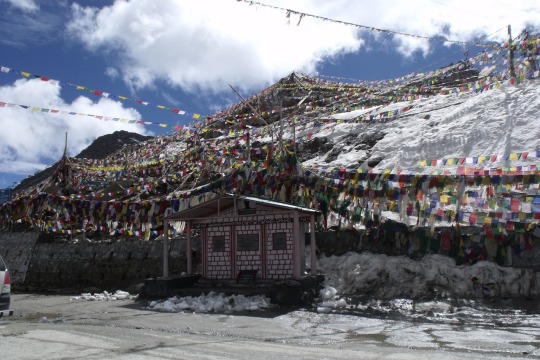
5. Kasha Monastery: Karsha Monastery, located in the Zanskar Valley of Ladakh, India, is one of the largest and most significant monastic institutions in the region. Dating back over a thousand years, this ancient Buddhist monastery is perched on a hill, offering spectacular views of the Zanskar River and the surrounding valley. Karsha Monastery is renowned for its impressive collection of religious artefacts, ancient murals, and a serene ambiance perfect for meditation and spiritual reflection. It plays a vital role in preserving and propagating Tibetan Buddhism in Zanskar. The annual Gustor Festival at Karsha Monastery is a vibrant celebration that draws both locals and travellers, making it a must-visit destination for those interested in Ladakhi culture and spirituality.
6. Drang-Drung Glacier: The Drang Drung Glacier, nestled in the Zanskar region of Ladakh, India, is a breathtaking natural wonder in the Himalayas. Surrounded by towering peaks, this massive glacier spans several kilometres, making it one of the largest in the region. The glacier's pristine white expanse contrasts with the azure skies and rugged landscape, creating a surreal and mesmerising sight. The Drang Drung Glacier is the primary source of the Zanskar River, which flows through the valley, sustaining the local ecosystems and communities. Its remote and serene ambiance, coupled with its ecological significance, attracts both adventure seekers and nature enthusiasts, making it a captivating destination in the heart of the Himalayas.
7. Phugtal Monastery: Phugtal Monastery, perched dramatically on a cliff in Zanskar Valley, Ladakh, is a captivating Buddhist haven. This ancient spiritual retreat is accessible primarily through a challenging trek, adding to its mystique. Dating back to the 12th century, it's renowned for its unique honeycomb-like structure carved into the mountainside, housing numerous prayer rooms, libraries, and living quarters. Phugtal Monastery's remote location amidst stunning Himalayan scenery, with the Lungnak River flowing nearby, creates an awe-inspiring atmosphere. Its spiritual significance, architectural marvel, and isolation make it a must-visit destination for those seeking both cultural insights and breathtaking natural beauty in the heart of the Himalayas.
Conclusion
The Zanskar Valley is a beautiful blend of natural beauty and cultural richness. Its monasteries, landscapes, and spiritual ambiance make it an ideal destination for both adventurers and those seeking cultural immersion. Zanskar's serene charm and stunning vistas leave an indelible mark on all who visit.
lehladakh
0 notes
Text
Chadar Trek: An Adventure of a Lifetime on the Frozen Zanskar River
Ladakh, often referred to as the "Land of High Passes," is a region in India that's known for its breathtaking landscapes, rich culture, and thrilling adventures. If you're someone who seeks adrenaline-pumping experiences and a deep connection with nature, Ladakh is the place to be. In this blog, we're going to delve into the exhilarating world of the Chadar Trek—an adventure of a lifetime on the frozen Zanskar River. But before we embark on this frozen journey, let's take a moment to explore two other gems of Ladakh: Pangong Lake and the monasteries of Ladakh that dot its terrain.
Chadar Trek: A Frozen Odyssey
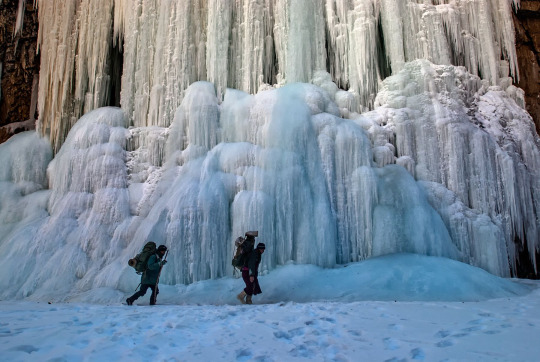
The Chadar Trek, often referred to as the 'Frozen River Trek,' is a winter expedition that takes trekkers through the heart of Ladakh's most remote and surreal landscapes. This trek is unique in its own right because it involves walking on a frozen river, the Zanskar River, which transforms into a thick sheet of ice during the harsh winter months. The name 'Chadar' translates to 'sheet' or 'blanket,' signifying the frozen blanket that covers the river's surface.
The Frozen Zanskar River: A Treacherous Beauty
The Chadar Trek, spanning around 105 kilometers, is not for the faint-hearted. It's a challenging adventure that requires physical endurance, mental strength, and the ability to adapt to extreme cold conditions. The temperatures can plummet to as low as minus 30 degrees Celsius, making it one of the coldest treks in the world. But those who dare to undertake this journey are rewarded with a surreal and almost otherworldly experience.
Traversing the Chadar: The Adventure Begins
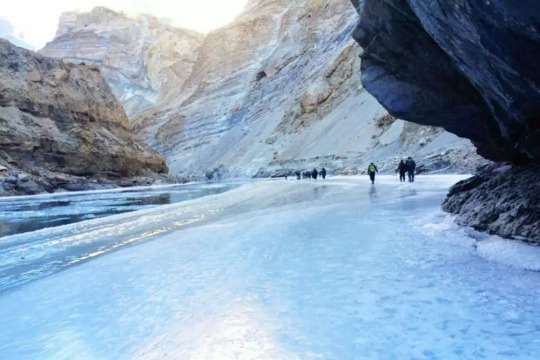
The trek typically starts from the village of Chilling, and trekkers traverse the frozen river to reach the village of Nerak. Along the way, you'll encounter stunning frozen waterfalls, towering icy cliffs, and the mesmerizing ice formations of the Zanskar River. The frozen landscape is a photographer's dream, with every turn offering a new and astonishing vista.
The key to surviving the Chadar Trek is proper acclimatization and ensuring you have the right gear. Thick layers of clothing, insulated boots, and a good quality sleeping bag are essential. Also, it's crucial to follow the instructions of experienced local guides who are well-versed in the region's conditions and can ensure your safety.
The Chadar Trek Experience: Beyond the Frozen Surface
While the Chadar Trek is undoubtedly an adventure of a lifetime, it's not just about conquering the physical challenges. It's also a journey into the heart of Ladakh's culture and traditions. Along the way, you'll have the opportunity to interact with the local Zanskari people, who have developed a way of life uniquely adapted to the harsh winters of the region.
You'll get a taste of their warm hospitality as you stay in traditional Ladakhi homes and experience their way of life. The Chadar Trek is a cultural exchange as much as it is an adventure, allowing you to gain a deeper appreciation for the people who call this frozen wilderness their home.
The Best Time to Embark on the Chadar Trek
The Chadar Trek season typically spans from January to February when the Zanskar River is frozen enough to support trekking. These months offer the most reliable conditions for the adventure, although the biting cold adds an extra layer of challenge to the journey.
A Bond with Nature: The Chadar Trek's Unforgettable Moments
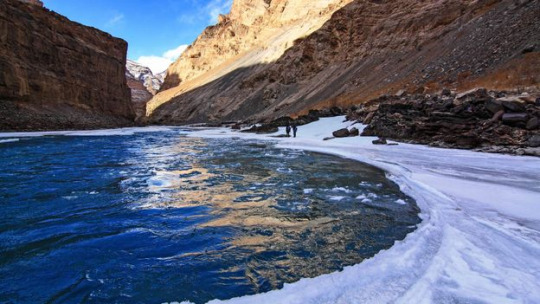
Amidst these challenges, the Chadar Trek offers moments of serenity and connection with nature that are truly unforgettable. It's a trek where you'll find solace in the silence of the frozen wilderness, broken only by the occasional creaking of the ice beneath your feet. The starlit nights in cozy caves along the riverbank provide an opportunity for introspection and awe at the vastness of the universe.
Throughout the journey, you'll be surrounded by the stark beauty of Ladakh's winter landscape. The ice formations take on surreal shapes, resembling frozen waves, icy stalactites, and crystalline curtains. As you walk through narrow canyons carved by the river, you'll feel like an explorer in an alien world, discovering hidden wonders at every turn.
A Glimpse into Local Life
The Chadar Trek is also an opportunity to connect with the indigenous Zanskari people who call this region home. These resilient locals have mastered the art of survival in this unforgiving environment. Their warmth and hospitality are a testament to the human capacity for kindness even in the harshest of conditions.
You'll have the chance to visit remote Zanskari villages and experience their way of life. You might share a cup of butter tea with a local family, hear folktales by the warmth of a traditional Bukhari (a wood-burning stove), and gain insights into the ancient traditions and customs that have sustained these communities for generations.
In Ladakh, where every corner seems like it's been touched by the divine, the Chadar Trek is an experience that stands out. It's not just a physical journey but a spiritual and cultural one too. The frozen Zanskar River is not just a frozen surface; it's a bridge that connects trekkers with the heart and soul of Ladakh.
So, if you're seeking an adventure that takes you to the edge of your limits and beyond, the Chadar Trek awaits. Just remember to be well-prepared, stay safe, and embrace the magic of Ladakh, both on and off the frozen river.
0 notes
Text
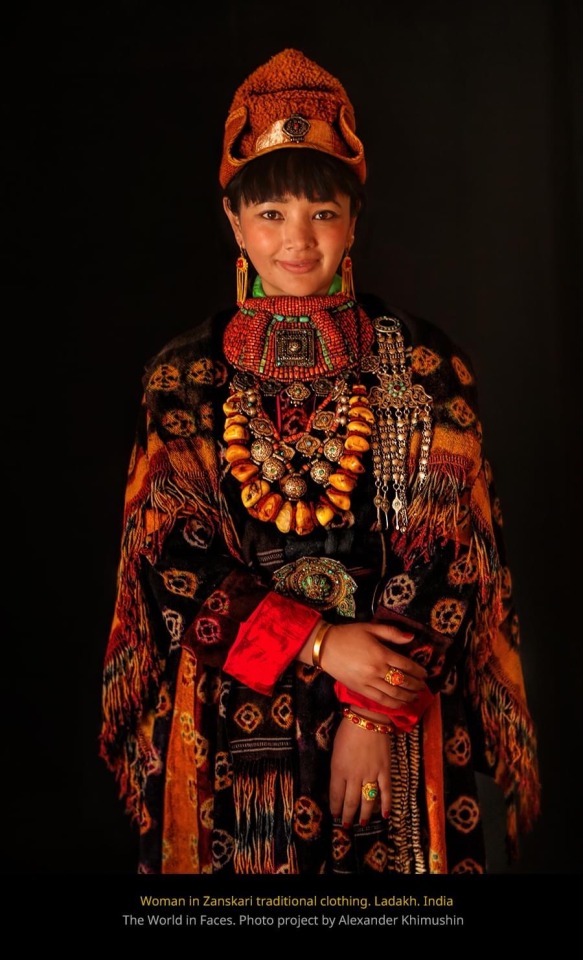
Young woman in Zanskari traditional clothing. Ladakh. India. ❤️🤗
On this photo beautiful Tsering Angmo is wearing one of the finest sets of Zanskari People traditional clothing and jewelry that I was able to find. I am really happy to have such a great opportunity and to show you Zanskari traditional clothing at its best.
Zanskar is one of regions of Ladakh, India with its own traditional culture. Zanskar mountain range separates Zanskar Valley from Ladakh itself. The average height of the range is about 6,000 m (19,700 ft). Zanskar Valley covers an area of some 7,000 km2 (2,700 mi2). As of last census in 2006 these enormous area had a population of less than 14,000 people.
The first traces of human activity in Zanskar go back as far as the Bronze Age. Petroglyphs attributed to that period suggest that their creators were hunters on the steppes of central Asia, living between Kazakhstan and China. Early Buddhism came here as early as 200 BC. In 7th century Zanskar and large parts of the Western Himalaya got under control of Tibetans, who brought here their then animistic Bön religion. Buddhism regained its influence over Zanskar in the 8th century when Tibet itself was also converted to this religion.
Roughly 95% of the inhabitants practice Tibetan Buddhism, while the remainder are Sunni Muslims, whose ancestors settled here in the 19th century. The majority of Zanskaris are of mixed Tibetan and Indo-European origins.
The population lives mainly in scattered small villages, the largest being the capital Padum, with about 700 inhabitants. Most of the villages are located in the valley of Zanskar river. Given the isolation of this region, the inhabitants, until recently lived in almost complete self-sufficiency. External trade has, however, always been necessary for the acquisition of goods such as tools, jewelry, or religious artefacts.
The Zanskaris' main occupations are cattle-rearing and farming of their own land. In the summer, the women and children stay far away from the villages to tend the yaks. This system is similar to the one found in the Alps where the animals are sent during the summer higher up in the mountains to the alpine meadows. People here have also developed a system of intensive arable agriculture and complex irrigation to produce enough food in these conditions. The scarcity of cultivable land has also resulted in no growth of the population for a very long period of time. An efficient birth-control system in Zanskar has historically been achieved by the common practice of polyandrous marriage, in which several brothers are married to the same wife, although these days it is not common anymore. There are only a few remained aged people families in villages that still live this way.
In the mid-20th century border conflicts between India, Pakistan and China caused to Zanskar ban to foreigners for many years. Because of its extreme isolation Zanskar has remained one of the most culturally intact part of Himalayas, however due to new roads built in recent years it started to experience rapid changes that threaten Zanskari People traditional culture and way of life.
One World. One People. One Love. 🌏❤️☮️🙏📸
The World in Faces photo project by Alexander Khimushin.
1 note
·
View note
Video
Zanskar valley by Satyan Sharma
Via Flickr:
Zanskar (ཟངས་དཀར་ zangs dkar) appears as “Zangskar” mostly in academic studies in social sciences (anthropology, gender studies), reflecting the Ladakhi pronunciation, although the Zanskari pronunciation is Zãhar.
1 note
·
View note
Text
Experience beautiful Himalayan itinerary
India is full of wonderful experience. Trips and treks to Himalayas is among the most popular adventure which one can enjoy. If you are planning a refreshing trip for yourself, do not miss to check out below amazing spots in the laps of Himalayas.
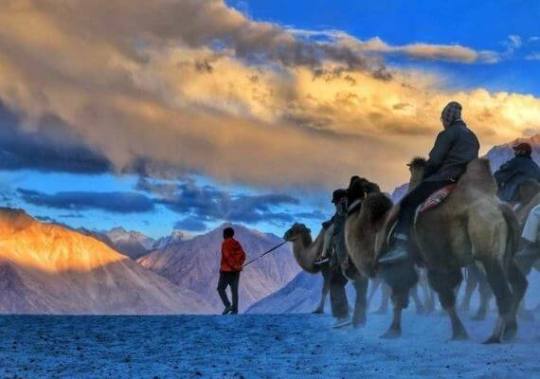
Leh Ladakh Bike Trip
For every adventure enthusiast, Leh Ladakh bike trip is always on the top of their bucket list. No doubt, Leh Ladakh which is flanked by Himalayas from every side, offers amazing experiences to every traveller visiting from all around the world.
The destination is easily accessible by every transportation mode, but exploring amazing views of Ladakh by bike has its own charm.So, you should prepare yourself for Leh Bike trip to make your way via the ancient monasteries, rugged terrains, treacherous roads, and mountain slopes alongside of gurgling rivers.
You will not be able to resist capturing pictures of unparalleled view offered by entire itinerary of Leh Ladakh.You should book this cost-effective trip to get a wonderful experience.
Roopkund lake trek
Roopkund trek is must to do trek in India. It has got everything which you want to do explore in a classic trek. Ice & snow, miles of undulating meadows, breathtaking campsites, gurgling brooks, deep virgin forests and a taste of amazing adventure as you explore the Roopkund lake trek from 8,000 ft to 16,000 ft in just six days.
Roopkund trek is among the most popular trek in India and offers amazing places for perfect picture. You will witness gorgeous dark forest, suddenly busting into Ali & Bedni Bugyal which is among India’s most beautiful high-altitude meadows. Just after crossing meadows, you can enjoy mesmerizing view of alpine stretches.
Climbing on beautiful snow to the trek is a heart pounding thrill. Along with all picturesque view you will also enjoy beautiful view of Mt. Trishul which looms over the trek and it gets closes by each step of yours.
KheerGanga trek
Kheerganga trek will give you an opportunity to take a bath in hot spring water after the tiring 8 hours ascent to the top of Kheer Ganga.
During the trek you can witness scenic views from lush green forests and villages due to which it is a perfect halt and are also perfect for delving into the mesmerizing beauty of Parvati valley. You can also see wonder mountains covered in snow which will come close to you as you walk closer to the trail.
This is one of the pleasant trek where you can also enjoy remote villages, countless waterfalls and much more. Duration of the trek is of 2 days and one night and can be easilydone if you are a beginner.
Chadar trek
This amazing trek in Leh Ladakh is suitable for people who want to experience extremely cold weather at an altitude of 5,000 meters (16,400 ft). You need a good stamina to enjoy the wonderful beauty of 5 KM in just 30 minutes.
This is a 62 KM trek which should be done by experienced trekkers. The trek can be completed in 8 days where you can also enjoy delicious food and campaign at breath-taking views of Himalayas.
During the trek you will feel like walking on the glass like river with beautiful mountains in both sides. The trek will give you an experience of trek to North Pole as the temperature drop to -30 degrees during night.
Food for campaign is supplied on sledges which makes it a do or die trek in your life. Chadar trek will also let you gain knowledge about Zanskari culture which is a perfect mixture of Indian and Tibetan culture. Along with this you will also enjoy the great hospitality of the local people. The best part of the trek is the Nerak waterfall which is completely iced from top to bottom.
Wrap Up
Visit to Himalayas is very peaceful, either it is in the form of bike trip to Leh or trekking to most stunning places of Himalayas, both activities have the power to give you wonderful experience.
0 notes
Text
Bike Trip to Leh Ladakh from Chandigarh

A Journey Through the Mesmerizing Landscapes Leh Ladakh is a popular tourist destination, known for its breathtaking natural beauty, rich cultural heritage, and adventurous opportunities. It is a dream destination for many travelers and adventure enthusiasts, and a bike trip from Chandigarh to Leh Ladakh is one of the most thrilling ways to explore this beautiful region.
Chandigarh to Leh distance is approximately 740 km, and the journey is a mixture of smooth and rough terrains. The journey from Chandigarh to Leh is full of stunning landscapes and breathtaking views, making it an unforgettable experience for every traveler. CHD to Leh distance is usually covered in two days, but it is recommended to take a few extra days to properly explore the region and acclimatize to the high altitude.
The journey from Chandigarh to Leh is not just about the destination, but also about the journey itself. As you travel through the Himalayas, you will come across various mountain passes, rivers, and valleys, all of which are incredibly beautiful and breathtaking. The road to Leh is considered to be one of the most challenging and adventurous roads in India, and it is a true test of your riding skills.
The ride from Chandigarh to Leh Ladakh is full of surprises. As you move closer to Ladakh, the landscape changes dramatically, and you will encounter unique and diverse cultures, including the Ladakhi, Zanskari, and Tibetan cultures. The food, the people, and the architecture in Leh Ladakh are all worth exploring and will leave a lasting impression on you.
In conclusion, a bike tour to ladakh is a once-in-a-lifetime experience. It is a journey that will test your limits, but the rewards are well worth it. Whether you are an experienced biker or a beginner, this trip will be one of the most memorable journeys of your life. So pack your bags, get your bike ready, and embark on an adventure that you will never forget.
0 notes
Text

Zaniskari
#zaniskari#zanskari#zanskar river#ladakh#india#horse#horses#working animals#workhorse#horse breeds#horse breeding#mountain horse#pony#wikipedia#wikipedia pictures#nature#animals
23 notes
·
View notes
Text
Why December Is The Best Time To Plan Your Chadar Trek 2023?
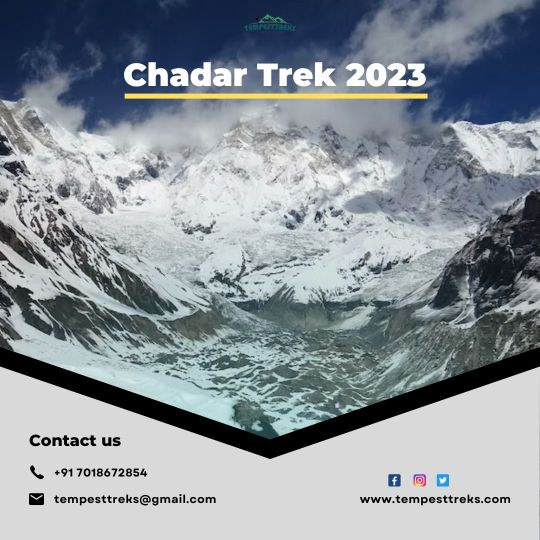
Have you heard about Chadar Trek? It is also known as Chadar frozen river trek. The frozen river Chadar trek is the most popular winter trek in India. It is a 9-day trek which includes walking on the frozen river of Zanskar and the temperature will be as low as -30 degree Celsius.
This trek will take place in the beautiful land of Ladakh. The Chadar trek will offer you a truly unforgettable experience of your lifetime. During the winter, as the temperature drops below minus degree Celsius, a thick layer of ice will develop on the river of Zanskar.
This layer of ice will as the highway that will connect Leh with the Zaskar Valley. For hundreds of years, Zanskari people will use the ice layer to travel from one place to another. The ice will save them time since it will cut down the extra miles they have to cover to reach the destination.
Now, we are in the last month of 2022. Hence it’s the best time for booking the Chadar trek 2023.Many agencies have opened the Chadar trek booking now. You can plan for a short or long Chadar trek. Based on your free time, you can book the right Chadar trek package. Though there is a road network, the ice path is usually chosen by many people since it will help them get a great experience.

Why Look For Chadar Trek 2023?
We should accept the fact that the winter in Ladakh will be truly mesmerizing. With the light snow covering the landscape and mountains, the place will transform into a new place where the day starts when the sun is at its zenith.
Leh market is the main hangout spot with the people relaxing on the benches and looking at the sun. In the nearby restaurants, you can enjoy your hot cup of coffee, tea or soup. Know that the Chadar trek 2023 will be extremely cold. The temperature during your Chadar frozen river trek will be as low as -30 degree Celsius. As the river flows at the bottom of the valley, you can find that the temperature is very low here.
The slight breeze which moves downstream will add a chill to the wind as well. Also, you have to cover around 50 kilometres during your trekking. If your health condition is good, then you can start your Chadar trek booking. This long trek in the cold climate makes it one of the hardest trekking in India. Make sure that you have more layers of clothes, especially during the night you will not get affected by the cold weather.
You may look at yourself shivering at some time. if you don’t wear warm clothes higher are chances that you may freeze. Hence, make sure that you have all the required things along with you during the trekking. This may appear crazy, but if you book your Chadar trek package and complete the trekking, then you will find that it's the most important and best step you took in your life.
Follow Us On Our Social Media Pages
Facebook, Instagram, Twitter
#chadar trek 2023#chadar trek booking#chadar frozen river trek#frozen river chadar trek#chadar trek package#chadar trek cost
0 notes
Photo
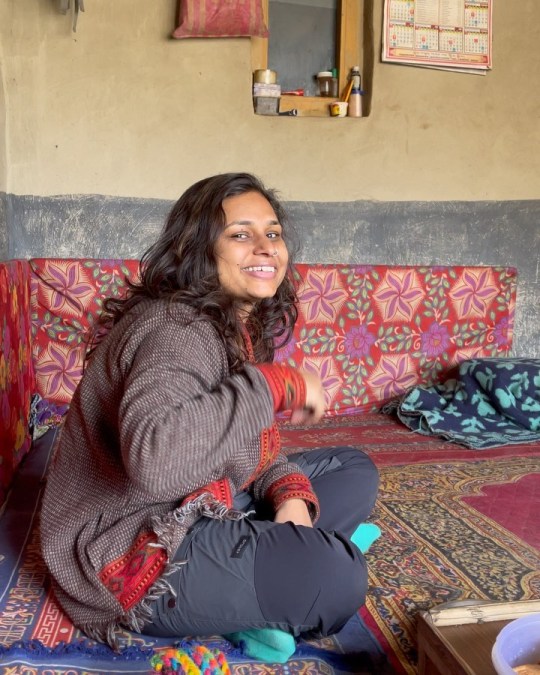
Some beautiful memories created with the loveliest of people we met on our recent Jeep Safari to Zanskar. Hosted by a humble lady from the village of Ichar we had our lunch at her home. #puresouls Join us to cherish immersive experiences like these on our currently running tours to Zanskar. July, August and September being the best time to visit the area. Next we leave on 24th of July, 2022 #travelwithlocals . . #zanskar #ichar #zanskari #culturalexperience #immersiveexperience #culturaltour #zanskarjeepsafari #exploration #explore #explorewithlocals #explorewithhippieinhills #vocalforlocal #himalayankingdom #shangrila #himalayan #himalaya #hippieinhills (at Zanskar) https://www.instagram.com/p/CgOlzh3pBQA/?igshid=NGJjMDIxMWI=
#puresouls#travelwithlocals#zanskar#ichar#zanskari#culturalexperience#immersiveexperience#culturaltour#zanskarjeepsafari#exploration#explore#explorewithlocals#explorewithhippieinhills#vocalforlocal#himalayankingdom#shangrila#himalayan#himalaya#hippieinhills
0 notes
